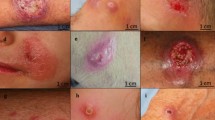Abstract
Cutaneous leishmaniasis (CL) caused by Leishmania major is common in southern Israel, while Leishmania infantum (sub-strain of L. donovani, causing zoonotic visceral leishmaniasis) infections were rarely reported in Israel and only in other regions. We report the first case of L. infantum infection in southern Israel, presented atypically as CL in an immunosuppressed 47-year old male. The patient was treated with liposomal amphotericin-B and recovered, without extra-cutaneous complications. Diagnosis of L. infantum CL was confirmed by microscopic identification of amastigotes in Gimsa-stained smear of skin lesion, positive blood serology and a positive polymerase chain reaction (PCR) amplification of the internal transcribed spacer 1 genes (ITS1) and restriction fragment length polymorphism (ITS1 PCR-RFLP). We also review the medical literature on old- world CL caused by L. infantum. Multiple L. donovani/infantum CL cases were identified in the literature search. These can be divided schematically to two: 1) In several endemic countries, L. infantum strains are the main causative agents of CL; 2) In other regions, CL is almost exclusively caused by L. major or L. tropica, while L. donovani strains CL cases were reported sporadically or as imported disease.
Similar content being viewed by others
References
Antoniou M., Haralambous C., Mazeris A., Pratlong F., Dedet J.P., Soteriadou K. 2008. Leishmania donovani leishmaniasis in Cyprus. The Lancet Infectious Diseases, 8, 6–7. DOI: 10.1016/S1473-3099(07)70297-9
Azmi K., Schonian G., Nasereddin A., Schnur L.F., Sawalha S., Hamarsheh O., Ereqat S., Amro A., Qaddomi S.E., Abdeen Z. 2012. Epidemiological and clinical features of cutaneous leishmaniases in Jenin District, Palestine, including characterisation of the causative agents in clinical samples. Transactions of the Royal Society of Tropical Medicine and Hygiene, 106, 554–562. DOI: 10.1016/j.trstmh.2012.06.005
Ben-Shimol S., Sagi O., Codish S., Novack V., Barrett C., Fruchtman Y., Berkowitz A., Shemer-Avni Y., Greenberg D. 2015. Dramatic increase in laboratory-diagnosed human cutaneous leishmaniasis cases in southern Israel, 2007–2013. Infectious Diseases, 47, 161–167. DOI:10.3109/00365548.2014.977342
Elamin E.M., Guizani I., Guerbouj S., Gramiccia M., El Hassan A.M., Di Muccio T., Taha M.A., Mukhtar M.M. 2008. Identification of Leishmania donovani as a cause of cutaneous leishmaniasis in Sudan. Transactions of the Royal Society of Tropical Medicine and Hygiene, 102, 54–57. DOI: 10.1016/j.trstmh.2007.10.005
Faber W.R., Wonders J., Jensema A.J., Chocholova E., Kager P.A. 2009. Cutaneous leishmaniasis with lymphadenopathy due to Leishmania donovani. Clinical and Experimental Dermatology, 34, e196–198. DOI: 10.1111/j.1365-2230.2008.02996.x
Ito K., Takahara M., Ito M., Oshiro M., Takahashi K., Uezato H., Imafuku S. 2014. An imported case of cutaneous leishmaniasis caused by Leishmania (Leishmania) donovani in Japan. The Journal of Dermatology, 41, 926–928. DOI: 10.1111/ 1346-8138.12609
Jacobson R.L. 2011. Leishmaniasis in an era of conflict in the Middle East. Vector-Borne and Zoonotic Diseases, 11, 247–58
Khatri M.L., Di Muccio T., Gramiccia M. 2009. Cutaneous leishmaniasis in North-Western Yemen: a clinicoepidemiologic study and Leishmania species identification by polymerase chain reaction-restriction fragment length polymorphism analysis. Journal of the American Academy of Dermatology, 61, e15–21. DOI: 10.1016/j.jaad.2009.04.047
Mebrahtu Y.B., Van Eys G., Guizani I., Lawyer P.G., Pamba H., Koech D., Roberts C., Perkins P.V., Were J.B., Hendricks L.D. 1993. Human cutaneous leishmaniasis caused by Leishmania donovani s.l. in Kenya. Transactions of the Royal Society of Tropical Medicine and Hygiene, 87, 598–601
Michel G., Pomares C., Ferrua B., Marty P. 2011. Importance of worldwide asymptomatic carriers of Leishmania infantum (L. chagasi) in human. Acta Tropica, 119, 69–75
Monroy-Ostria A., Nasereddin A., Monteon V.M., Guzmán-Bracho C., Jaffe C.L. 2014. ITS1 PCR-RFLP Diagnosis and Characterization of Leishmania in Clinical Samples and Strains from Cases of Human Cutaneous Leishmaniasis in States of the Mexican Southeast. Interdisciplinary Perspectives on Infectious Diseases 2014:607287. DOI: 10.1155/2014/607287
Nagarajan P., Sloan B.S. 2015. Isolated Cutaneous Leishmaniasis by Leishmania donovani in a Soldier Returning From Afghanistan. The American Journal of Dermatopathology, 37, 591–592. D0I:10.1097/DAD.0000000000000119
Poeppl W., Walochnik J., Pustelnik T., Auer H., Mooseder G. 2011. Cutaneous leishmaniasis after travel to Cyprus and successful treatment with miltefosine. The American Journal of Tropical Medicine and Hygiene, 84, 562–565. DOI: 10.4269/ajtmh.2011.10-0645
Reithinger R., Dujardin J.C., Louzir H., Pirmez C., Alexander B., Brooker S. 2007. Cutaneous leishmaniasis. The Lancet Infectious Diseases, 7, 581–96
Schnur L.F., Nasereddin A., Eisenberger C.L., Jaffe C.L., El Fari M., Azmi K., Anders G., Killick-Kendrick M., Killick-Kendrick R., Dedet J.P., Pratlong F., Kanaan M., Grossman T., Jacobson R.L., Schonian G., Warburg A. 2004. Multifarious characterization of Leishmania tropica from a Judean desert focus, exposing intraspecific diversity and incriminating phlebotomus sergenti as its vector. The American Journal of Tropical Medicine and Hygiene, 70, 364–72
Siah T.W., Lavender T., Charlton F., Wahie S., Schwab U. 2014. An unusual erysipelas-like presentation. Dermatology Online Journal, 20, 21255.
Solomon M., Schwartz E., Pavlotsky F., Sakka N., Barzilai A., Greenberger S. 2014. Leishmania tropica in children: a retrospective study. Journal of the American Academy of Dermatology, 71, 271–277. DOI: 10.1016/j.jaad.2013.12.047
Svobodová M., Alten B., Zídková L., Dvorák V., Hlavacková J., Mysková J., Seblová V., Kasap O.E., Belen A., Votypka J., Volf P. Cutaneous leishmaniasis caused by Leishmania infantum transmitted by Phlebotomus tobbi. International Journal for Parasitology, 39, 251–256
Wall E.C., Watson J., Armstrong M., Chiodini P.L., Lockwood D.N. 2012. Epidemiology of imported cutaneous leishmaniasis at the Hospital for Tropical Diseases, London, United Kingdom: use of polymerase chain reaction to identify the species. The American Journal of Tropical Medicine and Hygiene, 86, 115–118. DOI: 10.4269/ajtmh.2012.10-0558
WHO. 2010. WHO Technical Report Series — Report of a meeting of the WHO Expert Committee on the Control of Leishmaniases, Geneva, 22–26 March, 2010. http://apps.who.int/iris/bitstream/10665/44412/1/WHO_TRS_949_eng.pdf
Xynos I.D., Tektonidou M.G., Pikazis D., Sipsas N.V. 2009. Leishmaniasis, autoimmune rheumatic disease, and anti-tumor necrosis factor therapy, Europe. Emerging Infectious Diseases, 15, 956–959. DOI: 10.3201/eid1506.090101
Ya’ari A., Jaffe C.L., Garty B.Z. 2004. Visceral leishmaniasis in Israel, 1960–2000. Israel Medical Association Journal, 6, 205–208
Author information
Authors and Affiliations
Corresponding author
Rights and permissions
About this article
Cite this article
Ben-Shimol, S., Sagi, O., Horev, A. et al. Cutaneous leishmaniasis caused by Leishmania infantum in Southern Israel. Acta Parasit. 61, 855–858 (2016). https://doi.org/10.1515/ap-2016-0118
Received:
Revised:
Accepted:
Published:
Issue Date:
DOI: https://doi.org/10.1515/ap-2016-0118




